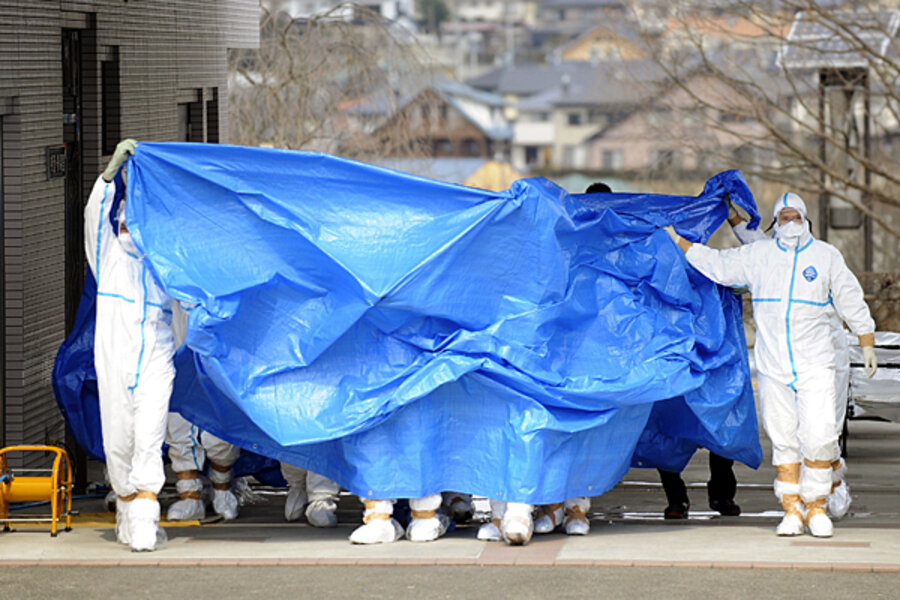Traces of Japanese radiation detected in 13 US states
Loading...
Elevated yet still very low levels of radiation from the Fukushima Daiichi nuclear crisis have now been detected in the air or water in more than a dozen US states and three territories, federal and local authorities say.
Higher than usual levels of radiation were detected by 12 monitoring stations in Alaska, Alabama, California, Guam, Hawaii, Idaho, Nevada, Saipan, Northern Mariana Islands, and Washington State over the past week and sent to Environmental Protection Agency scientists for detailed laboratory analysis, the agency said in a release Monday.
Unusual, yet still very low “trace amounts” of radiation, were also reported in Massachusetts rain water and by state officials and nuclear power plant radiation sensors in Colorado, South Carolina, North Carolina, Florida, and Pennsylvania, the Associated Press and Reuters reported.
“Some of the filter results show levels slightly higher than those found by EPA monitors last week and a Department of Energy monitor the week before,” the EPA said in its statement Monday. “These types of findings are to be expected in the coming days and are still far below levels of public health concern.”
While radiation levels now being seen in some rainwater exceed permitted levels for drinking water, for instance, the federal standard is calculated based on long-term exposure over 70 years – and those levels are expected to last only a relatively short while, the EPA said in a “frequently asked questions” portion of its statement.
One key radioactive particle being detected is iodine 131, a product of nuclear fission. Trace amounts of I-131 were trapped in clouds, and recent rains deposited I-131 in collection containers, the Massachusetts Department of Public Health reported Monday.
Rainwater called safe
For anyone who uses rainwater as a drinking water source, radiation exposure could be higher than for someone drinking from a public water system, though that level is still far to low to cause a health risk, the Centers for Disease Control said as part of a joint statement with the EPA and Food and Drug Administration.
“The levels being seen now are 25 times below the level that would be of concern for use as a sole source of water over a short period of time,” the CDC said in the joint statement, “even for infants, pregnant women or breastfeeding women, who are the most sensitive to radiation.”
Reporting of radiation levels comes from the EPA's network of radiation sensors in its RadNet system, which includes more than 100 real-time radiation air monitors in 48 states as well as 40 units it can deploy anywhere in the country.
“As a result of the incident with the Fukushima nuclear plant in Japan, several EPA air monitors have detected very low levels of radioactive material in the United States consistent with estimates from the damaged nuclear reactors,” the EPA said in its statement.
But even though short-term hikes “do not raise public health concerns” and such levels in rainwater are expected to be relatively short, the EPA said it would increase the monitoring of precipitation, drinking water, and other “potential exposure routes.”
Milk supply monitored
One key area being watched is the US milk supply. After the Chernobyl meltdown in 1986, it was found that cows had eaten grass tainted by radioactive fallout from the reactor. Concentrated radioiodine in the milk was blamed later for causing health problems in humans who drank it. The Soviet government was blamed for not warning the public.
Similarly, the US government was blamed for downplaying radioactive fallout as a health threat during atmospheric weapons testing in the 1950s and early 1960s. Such experience has translated into a high level of public distrust in many nations, experts say.
“As far as I can tell, the fallout today appears to be orders of magnitude less than it was during weapon testing in the 1950s when weapons-testing fallout occurred all over the country,” says Arjun Makhijani, president of Institute for Energy and Environmental Research in Takoma Park, Md., who has testified to Congress on the nuclear fallout issue. “Still, I would say there is a level of public concern that's high enough right now that the authorities absolutely should be measuring [radiation] levels in milk.”
In a statement Monday, the EPA and Massachusetts authorities said they were monitoring the milk supply at more than 30 stations. Typically this was done only once every three months, but sampling and evaluations were now being done “immediately,” the agency said.
The Food and Drug Administration added in a joint statement with EPA and other agencies that it was unlikely that radiation levels would contaminate milk to any degree that would harm health.
“At this time, theoretical models do not indicate that harmful amounts of radiation will reach the US and, therefore, there is little possibility of domestic milk being contaminated as a result of grass or feed contamination in the US,” the FDA said.
“As part of ongoing federal safety requirements, there is regular testing of milk and other selected foods for radioactivity and other potential contaminants,” added the Massachusetts Department of Health in the same release. “In initial testing, US EPA found no I-131 in milk products in the US.... This monitoring by the federal officials will continue in Massachusetts and other states.”





